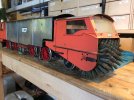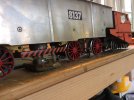I have been using my cleaning loco many many years now. Like 20, only changed the tires/wheels once, because the black plastic wheel cracked at the axel hole. The cleaning tire material, imho, is more akin to an ink eraser, hard and impregnated with fine grit.
it is critical to run the cleaning wheels at top speed, and the loco more slowly. Mine is analog. I use the roof potentiometer to make the loco move very slowly while the track voltage is 20v plus, making the cleaning wheels spin furiously, with an annoying ‘Star Wars ty-fighter-like whine’. (On my yellow analog version, when in cleaning mode, the cleaning wheels are directly connected to track voltage. This means, the track voltage should be 20v+, in order to really get them spinning, ‘normal’ v, eg 5-10 v, and they are very slow. The loco speed is regulated by the roof mounted potentiometer, under a small black plastic cap). Btw, the analog version has an internal cab switch which engages/disengages the roof speed control/ flashy roof lights.
i know nothing about any digital version, but, the speeds i suggest would still apply, however achieved.
if the cleaning wheels arent flying, it wont clean worth a jot.
if you’ve barely used yours, i cant imagine the cleaning wheels need to be replaced.
there is a video on how to replace the wheels. Imho, while the loco was dirty, the tires looked perfectly fine to me. Plenty of life left. Obviously, youll do no harm if you replace yours. Yes, they ‘smooth out’ and arent as abrasive as when new, but they are still effective, not unlike sandpaper after a use or 2.
i have tried ‘pulling’ cleaning wheels, and returned to factory standard. To throw the dust forward rather than into the cowel.
i find both to be about the same effectiveness. Unless,…….the track is wet, then front wheel drive is helpfu.
bouncing, it seems, may be from new cleaning tires being slightly out of round. I use mine anyway, they seem to eventually settle.
id say, use the tires until they are very thin. Or chipped, or develop a groove. Or the black plastic flanges have an issue.
Like the red lgb cleaning block, they last a long time. Occasionally cleaning the brass dust with detergent and toothbrush will restore maximum abrasion. I rarely do this.
i run mine in mid summer heat, direct sun on the rails, very very hot , no issues.
as gizzy sagely observes, it can take several passes to become shiny. If black, many passes.
typically, for me 1-2 passes, at slowest speed, does the trick. Track will have striating, no big deal. Effective, but not glistening.
i use it at least weekly, always after a rain, always before running any loco without skates (to reduce micro arcing and pitting). I do not let the track get really dark. If it does, the solution is the red block, imho.
as a practical matter, if i use the red cleaning block, one pass with a\elbow grease does more than 5 passes, and more evenly and thoroughly.
the cleaning tires last a very long time.
1 look for tiny black nylon ‘threads’ from the flange wrapping around the cleaning axel, and remove, (most frequently with fresh new plastic wheel flanges);you know this,
2 blow out the dust, after each use, (do not inhale the stuff); i deep clean yearly , ie disassemble, wash, pita)
3 do not add weight to the cowel to increase downward pressure on the cleaning wheels, as youll damage the cleaning apparatus sooner or later, so i have read.
4 never leave it unattended. Mine never derails, unless im inattentive. It will , in short time, place a divot on the rail if it stalls.




